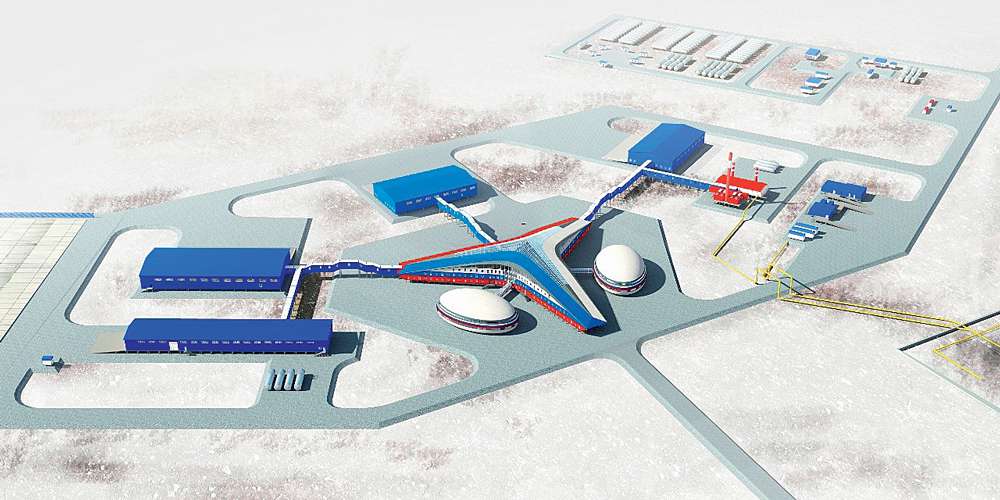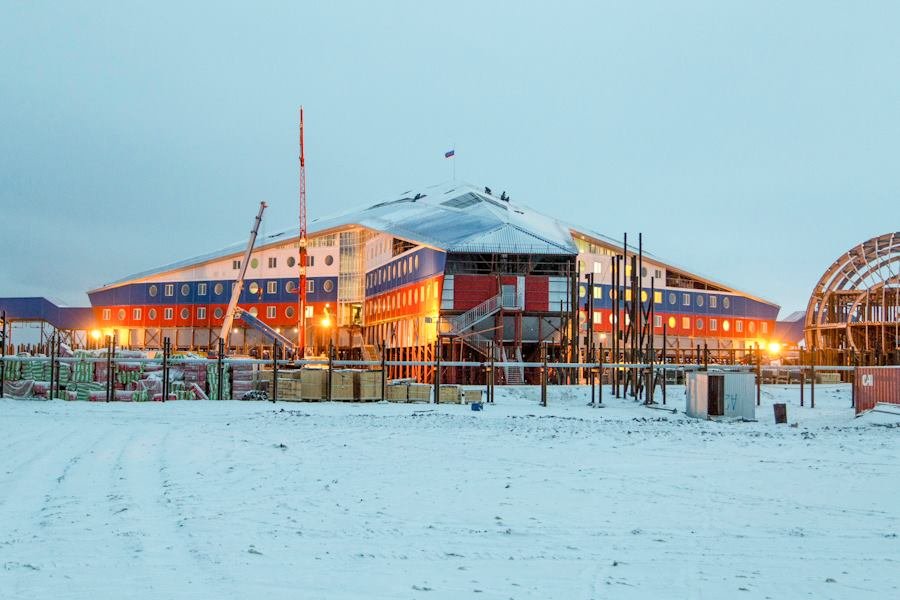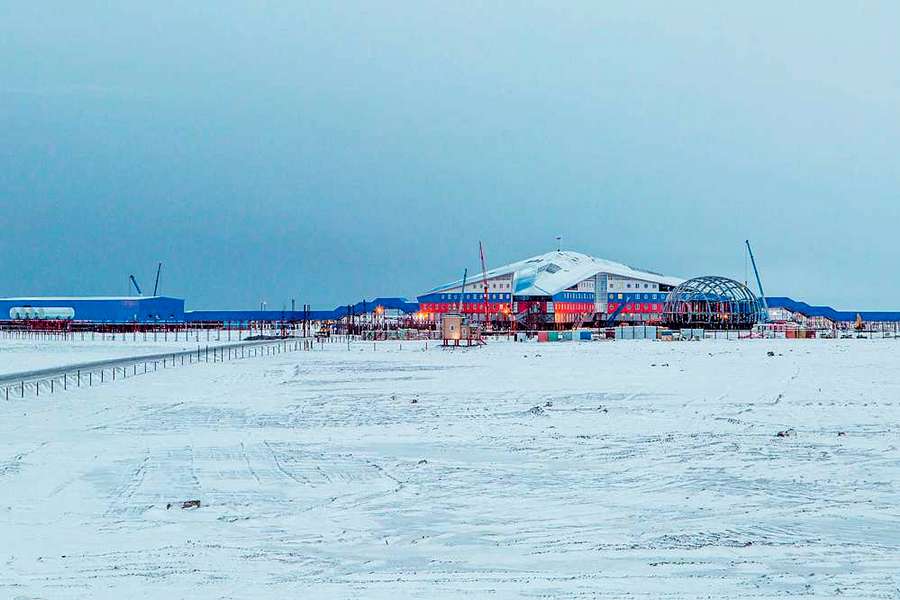
Originally appeared at Interpolit, translated by Theo N. Kaufman exclusively for SouthFront; Edited by Yoana
Defense Minister Sergei Shoigu visited the military base Alexandra Land Inspectorate on Monday. This is the most northerly situated base in the world. There will be permanently stationed aviation squadron.
The foremost novelty of the base – its housing and office complex “Arctic clover”, is a complex that provides an independent residency for the stationed troops without requiring them to engage the “open North” with its harsh climate.
The average July temperature of the “hot” months is 1 degree, in March it’s minus 24 degrees. The absolute minimum is minus 54 degrees. The polar days last from the 11th of April till the 31st of August. The frosting of the ground starts on September the 13th, and the snow lasts until 13th of July. The situation is exacerbated by strong winds, mainly from the south.
The base is designed for the long stay of 150 soldiers, both officers and contract soldiers and sergeants.
Alexandra – the island area of 1130 square kilometers, is part of the Franz Josef Land archipelago. During World War II, the island housed a German weather station and a submarine base.
The Soviet air base, located on the frontier part of the island, was established in 1947. As such, there was a scientific research centre for the public called, polar station “Nagurskaya”, and there were also air defense systems deployed on that island. In the early 90’s, all the Soviet legacies were closed, with the exception of the frontier. The coast of the island turned into a huge dumping place amassing waste -mostly empty barrels out of fuel- over the years.
By the end of the millenium, life on the island began to revive. A village of 5000 square meters was built, work began on the construction of a new airfield. First it was intended for cargo aircraft. In the future, it will be used for fighter jets.
To date, the following structures were constructed on the site: an energy generator, a fuel storage facility, a garage, and water and sewage systems. There was also the restoration of the meteorological services through the installation of automated equipment.
The relevance of the station of Alexandra as a military base has increased substantially since its establishment in December 2014 of the Joint Strategic Command “North”, it is intended to provide for the complete safety of Russia’s Arctic region. Its three main security tasks are the following: providing the defense of the Arctic shelf, the Arctic sea routes, and the Northern Sea Route and to guarantee the continued use of the Northwest Passage.
The structure of the command, based in the region includes surface and submarine forces, naval aviation, and coastal and air defense forces.
The main forces at the disposal of the command are the Northern Fleet, which was taken from the Western Military District. Thus, the daily command of the “North” is done by the commander of the Northern Fleet, Admiral Vladimir Korolev.
After the inspection of the base by the Minister of the Island, the restoration works of the military infrastructure were started by the Federal Agency for Special Construction of Russia, which was deployed in the villages of New Earth, Middle Island (Northern Land), Otto Schmidt Cape, Wrangel Island and the island of Boiler (New Siberian Islands).
A base built on the pole
The “Arctic clover” project began in 2007. The garage, the sewage treatment plant, the fuel storage, all of which are mentioned above, have already been built in the framework of this particular project, the cost of which amounts to 4.2 billion Rubles.
The conditions of construction work in the harsh Arctic environment is aggravated by the fact that all the construction material that is needed for the base has to be delivered to the island, including sand. At the same time the import via the Northern Sea Route can only be performed during the four warm months, when the ice is melted on the route.
As usual: in July of 2015 construction workers went on a strike due to their delayed salaries. As of now, due to the intervention by the Federal Agency for Special Construction of Russia, their salaries got paid.

At this moment, the construction works have been in progress for 4 months now. The works are carried out, even during the polar night, in 2-3 shifts.
The name “clover” describes the location of the geometry of the buildings and structures that are in the plan. They represent three rays emanating from a single center at an angle of 120 degrees. This form has already been used in the construction of complex “North clover” on Boiler Island. All connecting modules between the professional, technical and residential units are equipped with covered heated galleries.
In the place of convergence of the “rays”, there is a towering glass observation tower, which offers an overview of the whole territory of the military base. There is the five-story building, built on poles. Its total area covers 14921 square meters. The first floor houses the technical units- and has an area of 4390 square meters. The complex consists of 70 buildings and various structures for different purposes.
There is also a space for the stockpiling of food and beverages. This allows the base to operate autonomously from the outside world and to perform combat missions for a duration of 18 months.
The base is designed to house 150 troops. These troops consist of the following army branches:
– Aviation command – 30 people;
– Separate radar company – 50 people;
– Radar Air Controllers – 6 people;
– Anti-aircraft missile artillery battalion – 22 people;
– Variable composition of troops – 42 people.
The complex provides comfortable conditions for the military service in the Far North. There is a gym, a cultural and recreational unit, a dining area that includes cooking facilities for the preparation of 150 portions of food that can be selected from the menu.
In contrast to the Soviet period, when the northern islands were characterized as a messy place, the new complex has a garbage burning unit.
But, of course, the main purpose of the base – is providing comfort for its residents, not compliance with basic environmental standards. The base, forming part of a videoconferencing system, also plays the role of an air defense system. At the airport there is a runway extension to be constructed for the purpose of accommodating all types of aircraft. The new runway will have a length of 2.5 km and a width of 42 m. It is assumed that there will be a permanent basing on the station of Alexandra of the long-range interceptors MiG-31 or multi-functional fighter-bombers Su-34. The base will also be used to accommodate the Il- 78 tankers.

The airfield is equipped with an en-route “Sopka-2” radar system. The mobile altimeter PRV-13P will be used for intercepting fighter jets. As well as mobile radars Omnidirection P-18-2 “Terek”, which are capable of detecting a fighter at a distance of 150 km and that have a margin of error of 250 m, all the electronics will operate in a closed environment with the use of stealth.
The requirements in the Far North are crucial, if the record breaking cold temperatures on the base of Alexandra exceed 4 degrees, it will limit the working range for the radars.
The direct protection of the base against air raids will be provided by the Division called ZRPK “Sagarse-S.”
The opening of the “Arctic clover” is scheduled for December this year. It is expected that there will be an immediate placement of fighters and tankers.
In conclusion, we also must say something about the relevance of the construction of a Russian military base in the Arctic. There is ever growing evidence of the intensification of military activities in this region of the armed forces of adversary countries that have territorial disputes with Russia.
The Sunday Times reported last week that British submarines resumed the practice of patrolling the Arctic under the ice. The last time they did this was nine years ago, when their two sailors were killed in an emergency ascent. They decided to ignore this tragedy, because the stakes are too high- this could have cost them the opportunity to participate in the development of the rich reserves of natural resources. After this deadly voyage the nuclear submarine “Trafalgar” went on shore in Russia.
Another contender – is Norway. Its submarine fleet is not as strong as that of the UK and the US, but it is in close proximity to our northern borders and it also has quite capable aircraft, and strategic radars. And, of course, the country that has the most increasing appetite for Arctic hydrocarbons is the United States.



